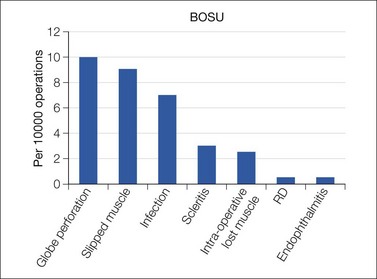Chapter 86 Strabismus surgery complications and how to avoid them
Incidence
The incidence and outcomes described are from a 2-year prospective survey of severe complications of strabismus surgery carried out by the author through the British Ophthalmic Surveillance Unit (BOSU) and the available literature. The incidence of severe complications of strabismus surgery was 2.5–3 per 1000. Globe perforation is the most common complication with almost an incidence of 1 : 1000. Retinal detachment and endophthalmitis are the least common reported (Fig. 86.1, Box 86.1 and Table 86.1). Anterior segment ischemia was not part of the BOSU study, but may be 1 : 13 000 operations.1 Eighteen percent of patients with a complication had a poor or very poor outcome: about 0.05% or 1 : 2000 of patients operated on.

Fig. 86.1 Incidence of severe complications of surgery, per 10 000 operations. RD = retinal detachment.
Box 86.1
Classification of outcome
Grade 2: Surgical or medical intervention but good outcome
Grade 3: Surgical or medical intervention asymptomatic but compromised outcome
Grade 4: Surgical or medical intervention but poor outcome, e.g. double vision or up to 2 lines of loss of vision on a Snellen chart
Grade 5: Very poor outcome, greater than 2 lines of visual loss on a Snellen chart
Mild complications (Box 86.2)
We devised a 5 point scale depending on the severity of outcome of the complication. This is outlined in Figure 4. The number of complications in the 5 categories split into adults and children is shown in Figure 5 with the p values. Although there were more infections and globe perforations in children and more SINS and lost muscle in adults only SINS reached statistical significance.
Dellen
Dellen tend to occur in the peripheral cornea, specifically nasal and temporal quadrants in the first 1–2 weeks following strabismus surgery. Dellen are thinning of the cornea due to the drying out of the collagen in the stroma related to poor corneal wetting. They are related to tear film disruption and altered anterior segment contour due to swollen conjunctiva which prevents the smooth travel of the eyelids. They are more common in adults, but may occur in children (who are rarely examined on the slit-lamp). The reported the incidence is between 0.3% and 22.45%.2 It is usually self-limiting or responds to topical lubricants; rarely a contact lens is required.
Severe complications (Box 86.3)
Anterior segment ischemia (Fig. 86.3)
The incidence of significant anterior segment ischemia (ASI) may be 1 : 13 000 cases.1 It was not surveyed in the BOSU study because ASI would be grossly underreported, especially in children where postoperative slit-lamp examination is not normally performed. Severe outcomes are rare although there is a report of phthisis bulbi.1 Risks factors for ASI include increasing age, previous rectus surgery, operations on multiple muscles (especially recti) in the same eye, circulation problems (i.e. hypertension or diabetes), similar surgery on adjacent rectus muscles, surgery on vertical rectus muscles, and a limbal incision.
Symptoms and signs of ASI can vary from mild uveitis and reduced iris perfusion to a keratopathy1,3 (Table 86.2).
Grade 1 ASI can only be detected by iris angiography.
Grade 2 ASI is caused by areas of iris hypoperfusion, sometimes an abnormally shaped pupil. It rarely requires treatment.
Grades 3 and 4 ASI usually require treatment with topical or systemic corticosteroids. Unusual treatments include hyperbaric oxygen. The vast majority recover with only minor sequelae including iris atrophy, corectopia, or a poorly reacting pupil.
Stay updated, free articles. Join our Telegram channel

Full access? Get Clinical Tree






